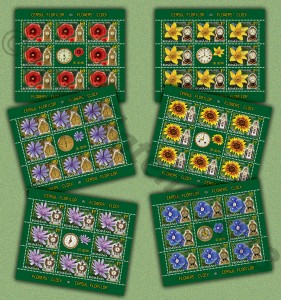 Have you ever taken into consideration that flowers do not all blossom at the same time? That there is a specific hour when each one reveals itself to the light, nature and peoples?
Have you ever taken into consideration that flowers do not all blossom at the same time? That there is a specific hour when each one reveals itself to the light, nature and peoples?
With an interesting thematic approach, this year, Romfilatelia is offering a two-part postage stamps issue, Flowers’ Clock. This issue, achieved in an original illustrative manner, combines the image of a flower with an exhibit from the Nicolae Simache Clock Museum in Ploiesti.
The postage stamp with the face value of 0.60 lei illustrates the Field Poppy (Papaver rhoeas) which blooming hour is 5 a.m.
It is an annual herbaceous 20-100 cm tall plant. Its stem, sprouting from a tap root, is ramified and has stiff hairs perpendicular on the stem axis. Its leaves are pinnate and divided. It has large single flowers consisting of two large green hairy sepals and four 4-6 cm long shiny red petals. The fruit is a 1-2 cm capsule in the form of a cup star-shaped in the upper side which includes several small brownish-black edible seeds. The plant is crossed by many vessels containing latex.
Next to the Field Poppy is represented a mantel clock, manufactured in France, in the 19th century.
On the postage stamp with the face value of 0.80 lei is illustrated the Common Chicory (Cichorium inthybus) which blooming hour is 6 a.m.
It is a perennial herbaceous and edible plant. It has been known ever since ancient times and was used inEgyptas a remedy for hepatobiliary and renal diseases. It is often cultivated for its roots from which a coffee substitute is obtained. The root is a thick tap root and the stem is upright ramified and can reach heights of up to two meters. The leaves at the bottom are stalked and deeply sunken and the ones on the stem are lanceolate and pointed to the tip.
The flowers are blue and individually grouped on the stem and the lateral branches. They blossom from July to the end of August.
Next to the Common Chicory is represented a carriage clock, manufactured in Austria, in the early 19th century.
The postage stamp with the face value of 1.00 lei illustrates the Viper’s Grass (Scorzonera rosea) which blooming hour is 7 a.m.
It is a herbaceous perennial plant growing in the mountain and subalpine areas, in grassland, meadows and glades. It can be recognised by its light pink star-shaped flowers. The stem is simple, smooth and 15-70 cm tall. The leaves at the bottom of the stem are long and arrowhead-shaped. It blossoms from June through August.
Next to the Viper´s Grass is represented a table clock, manufactured in Paris, in the late 19th century.
The postage stamp with the face value of 1.60 lei illustrates the Marsh Marigold (Caltha palustris), which blooming hour is 8 a.m.
It is a spontaneous perennial herbaceous plant. The stem is 20-55 cm tall, its leaves are shiny and kidney-shaped with a long petiole, and the flowers are golden-yellowish. The stamens are numerous and organized in a spiral.
It grows in excessively humid places from planes through the subalpine area. Just as many members of the Ranunculaceae family, to which it belongs, it is a toxic plant. It blossoms during the period April-June.
Next to the Marsh Marigold is represented a Neuchatele W.& A. Schmid-Schenker table clock, manufactured in Germany, in the first half of 20th century.
The postage stamp with the face value of 2.40 lei illustrates the Sunflower (Helianthus annuus) which blooming hour is 9 a.m.
It is an annual, herbaceous plant originating fromNorth America. It was brought toEuropein the 16th century to be cultivated mostly for its oil-rich seeds. The leaves are big, full and the stem with a height 2 meters and even 5 meters ends in a single yellow flower with a 25-50 cm diameter. The seeds contain, without the fruit rind, about 55% edible oil used in several industrial fields.
This plant has a unique characteristic, that of always facing the sun and following its trajectory all day long.
Next to the Sunflower is represented a P. Bonnet & P. Pottier portico clock, manufactured in Paris, in the late 19th century.
On the postage stamp with the face value of 5.00 lei is illustrated the Bird’s-eye Speedwell (Veronica chamaedrys) which blooming hour is 10 a.m.
It is a herbaceous, perennial, 10-40 cm tall plant. From April through June, on meadows, bushes and wood sides it is easily noticeable due to its beautiful light blue flowers. They blossom in the morning but, until night-time, they become violet-pinkish. Try picking it and you will see the flowers come off the plant very easily. The leaves are oval-triangular finely dentate and hairy. The fruits are heart-shaped.
The bird’s-eye speedwell is a medicinal plant used for treating diseases of the skin, kidneys, lungs and for blood purification.
Next to the Bird´s-eye Speedwell is represented a Boulle table clock case, manufactured in France, in the 19th century.
We would like to thank the Biology Institute of the Romanian Academy (PhD. Sorin Stefanut, Head of the Ecology, Taxonomy and Nature Preservation and PhD. student Roxana Ion, Plant Expert) and to the “Nicolae Simache” Clock Museum (Ploiesti) for the documentary support granted in the accomplishment of this postage stamps issue.
Issue date: 2013-01-25









